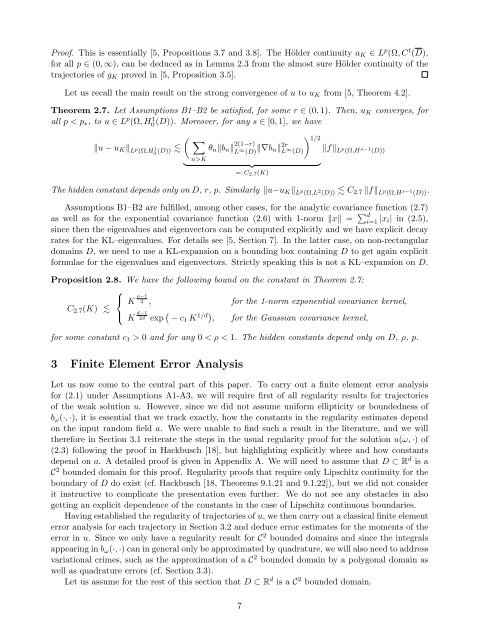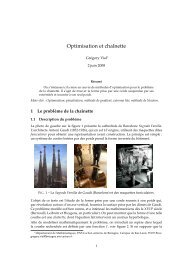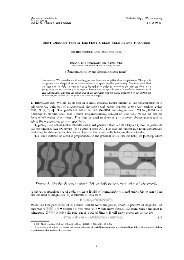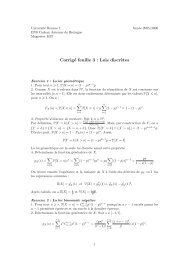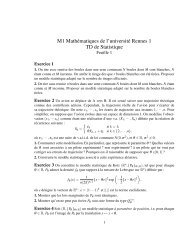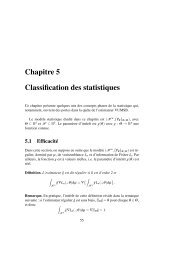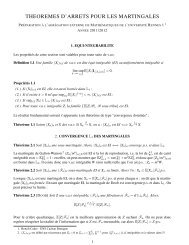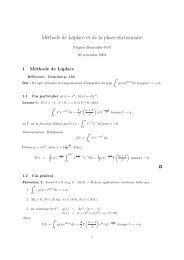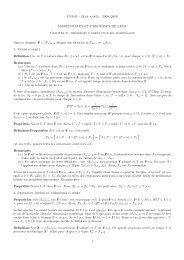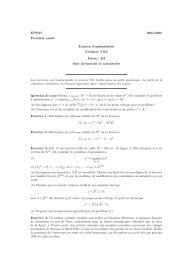Bath Institute For Complex Systems - ENS de Cachan - Antenne de ...
Bath Institute For Complex Systems - ENS de Cachan - Antenne de ...
Bath Institute For Complex Systems - ENS de Cachan - Antenne de ...
You also want an ePaper? Increase the reach of your titles
YUMPU automatically turns print PDFs into web optimized ePapers that Google loves.
Proof. This is essentially [5, Propositions 3.7 and 3.8]. The Höl<strong>de</strong>r continuity a K ∈ L p (Ω, C t (D),for all p ∈ (0, ∞), can be <strong>de</strong>duced as in Lemma 2.3 from the almost sure Höl<strong>de</strong>r continuity of thetrajectories of g K proved in [5, Proposition 3.5].Let us recall the main result on the strong convergence of u to u K from [5, Theorem 4.2].Theorem 2.7. Let Assumptions B1–B2 be satisfied, for some r ∈ (0, 1). Then, u K converges, forall p < p ∗ , to u ∈ L p (Ω, H0 1 (D)). Moreover, for any s ∈ [0, 1], we have‖u − u K ‖ L p (Ω,H 1 0 (D)) ( ∑n>K) 1/2θ n ‖b n ‖ 2(1−r)L ∞ (D) ‖∇b n‖ 2rL ∞ (D)} {{ }=: C 2.7 (K)‖f‖ L p (Ω,H s−1 (D))The hid<strong>de</strong>n constant <strong>de</strong>pends only on D, r, p. Similarly ‖u−u K ‖ L p (Ω,L 2 (D)) C 2.7 ‖f‖ L p (Ω,H s−1 (D)).Assumptions B1–B2 are fulfilled, among other cases, for the analytic covariance function (2.7)as well as for the exponential covariance function (2.6) with 1-norm ‖x‖ = ∑ di=1 |x i| in (2.5),since then the eigenvalues and eigenvectors can be computed explicitly and we have explicit <strong>de</strong>cayrates for the KL–eigenvalues. <strong>For</strong> <strong>de</strong>tails see [5, Section 7]. In the latter case, on non-rectangulardomains D, we need to use a KL-expansion on a bounding box containing D to get again explicitformulae for the eigenvalues and eigenvectors. Strictly speaking this is not a KL–expansion on D.Proposition 2.8. We have the following bound on the constant in Theorem 2.7:⎧⎨ K ρ−12 , for the 1-norm exponential covariance kernel,C 2.7 (K) ⎩K d−12d exp ( − c 1 K 1/d) , for the Gaussian covariance kernel,for some constant c 1 > 0 and for any 0 < ρ < 1. The hid<strong>de</strong>n constants <strong>de</strong>pend only on D, ρ, p.3 Finite Element Error AnalysisLet us now come to the central part of this paper. To carry out a finite element error analysisfor (2.1) un<strong>de</strong>r Assumptions A1-A3, we will require first of all regularity results for trajectoriesof the weak solution u. However, since we did not assume uniform ellipticity or boun<strong>de</strong>dness ofb ω (·, ·), it is essential that we track exactly, how the constants in the regularity estimates <strong>de</strong>pendon the input random field a. We were unable to find such a result in the literature, and we willtherefore in Section 3.1 reiterate the steps in the usual regularity proof for the solution u(ω, ·) of(2.3) following the proof in Hackbusch [18], but highlighting explicitly where and how constants<strong>de</strong>pend on a. A <strong>de</strong>tailed proof is given in Appendix A. We will need to assume that D ⊂ R d is aC 2 boun<strong>de</strong>d domain for this proof. Regularity proofs that require only Lipschitz continuity for theboundary of D do exist (cf. Hackbusch [18, Theorems 9.1.21 and 9.1.22]), but we did not consi<strong>de</strong>rit instructive to complicate the presentation even further. We do not see any obstacles in alsogetting an explicit <strong>de</strong>pen<strong>de</strong>nce of the constants in the case of Lipschitz continuous boundaries.Having established the regularity of trajectories of u, we then carry out a classical finite elementerror analysis for each trajectory in Section 3.2 and <strong>de</strong>duce error estimates for the moments of theerror in u. Since we only have a regularity result for C 2 boun<strong>de</strong>d domains and since the integralsappearing in b ω (·, ·) can in general only be approximated by quadrature, we will also need to addressvariational crimes, such as the approximation of a C 2 boun<strong>de</strong>d domain by a polygonal domain aswell as quadrature errors (cf. Section 3.3).Let us assume for the rest of this section that D ⊂ R d is a C 2 boun<strong>de</strong>d domain.7


